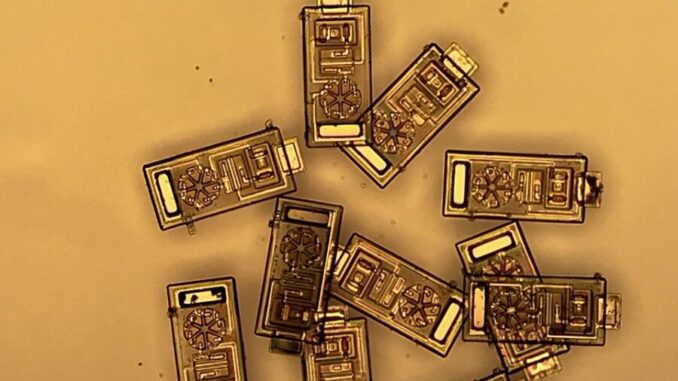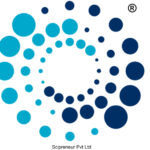
ITHACA, N.Y. – Cornell University researchers who build nanoscale electronics have developed microsensors so tiny, they can fit 30,000 on one side of a penny. They are equipped with an integrated circuit, solar cells and light-emitting diodes (LEDs) that enable them to harness light for power and communication. And because they are mass fabricated, with up to 1 million sitting on an 8-inch wafer, each device costs a fraction of that same penny.
The sensors can be used to measure inputs like voltage and temperature in hard-to-reach environments, such as inside living tissue and microfluidic systems. For example, when rigged with a neural sensor, they would be able to noninvasively record nerve signals in the body and transmit findings by blinking a coded signal via the LED.
As a proof of concept, the team successfully embedded a sensor in brain tissue and wirelessly relayed the results.
The team’s paper, “Microscopic Sensors Using Optical Wireless Integrated Circuits,” published in PNAS.
The collaboration is led by Paul McEuen, professor of physical science, and Alyosha Molnar, associate professor of electrical and computer engineering. Working with the paper’s lead author, Alejandro Cortese, a Cornell Presidential Postdoctoral Fellow, they devised a platform for parallel production of their optical wireless integrated circuits (OWICs) – microsensors the size of 100 microns (a micron is one-millionth of a meter), mere specks to the human eye.
The OWICS are essentially paramecium-size smartphones that can be specialized with apps. But rather than rely on cumbersome radio frequency technology, as cellphones do, the researchers looked to light as a potential power source and communication medium.
McEuen, Molnar and Cortese have launched their own company, OWiC Technologies, to commercialize the microsensors. A patent application has been filed through the Center for Technology Licensing. The first application is the creation of e-tags that can be attached to products to help identify them.
The tiny, low-cost OWICs could potentially spawn generations of microsensors that use less power while tracking more complicated phenomena.
###
The research was supported by the Cornell Center for Materials Research, with funding from the National Science Foundation’s Materials Research Science and Engineering Center program, the Air Force Office of Scientific Research and the Kavli Institute at Cornell for Nanoscale Science. Additional funding was provided by the National Institutes of Health and the National Science Foundation Graduate Research Fellowship.







Leave a Reply